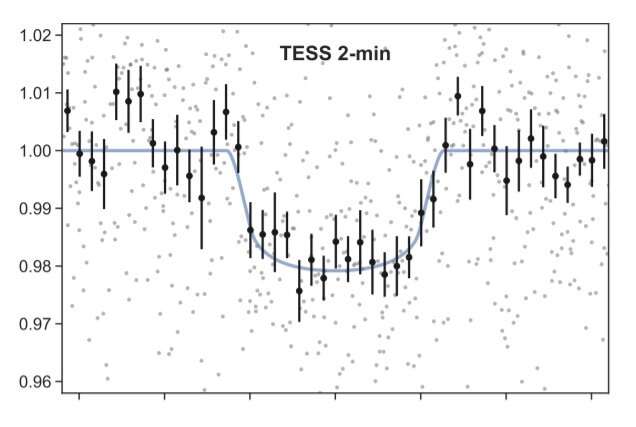August 5, 2021 report
Astronomers detect new large sub-Neptune alien world

Using NASA's Transiting Exoplanets Survey Satellite (TESS), an international team of astronomers has detected a new sub-Neptune exoplanet orbiting an M dwarf star. The newly found extrasolar world, designated TOI-2406 b, is nearly three times larger than the Earth. The discovery is reported in a paper published July 29 on arXiv.org.
TESS is conducting a survey of about 200,000 of the brightest stars near the sun with the aim of finding transiting exoplanets. So far, it has identified over 4,400 candidate exoplanets (TESS Objects of Interest, or TOI), of which 144 have been confirmed so far.
Recently, a team of astronomers led by Robert Wells of the University of Bern in Switzerland confirmed a new TESS planet around the star known as TOI-2406 (or TIC 212957629). TESS observed TOI-2406 in 2018 and 2020, which resulted in the detection of a transit signal in the light curve of this object. The planetary nature of this signal was confirmed by follow-up photometric and spectroscopic observations using various ground-based telescopes.
"Here, we report the discovery and validation of a sub-Neptune orbiting the thick-disk, mid-M dwarf star TOI-2406," the researchers wrote in the paper.
The newfound planet has a radius of about 2.94 Earth radii. The data show that the exoplanet orbits its parent star every 3.07 days, at a distance of approximately 0.023 AU from it. The equilibrium temperature of TOI-2406 b was measured to be around 447 K and the astronomers estimate that its predicted mass is some 9.1 Earth masses. The astronomers noted that TOI-2406 b turns out to be the largest known sub-Neptunes.
The host TOI-2406 is a metal-poor M4 V star, located at a distance of about 182 light years away from the Earth. The star has a radius of 0.2 solar radii and its mass is estimated to be around 0.16 solar masses. The effective temperature of this star is approximately 3,100 K, while its metallicity is at a level of -0.38.
Summing up the results, the astronomers emphasized how unusual the newly detected planetary system TOI-2406 is. They noted that the star's low metallicity and the relatively large size and short period of the planet make TOI-2406 b an unusual outcome of planet formation.
"The system consists of a large sub-Neptune orbiting a low-mass member of the thick disk. It is a challenge to the core accretion model of planet formation, where simulations struggle to produce large planets around metal-poor, late-type stars," the researchers wrote.
The authors added that further observations of TOI-2406 are necessary in order to get more insights into the system's properties. For instance, radial velocity follow-up studies are needed to determine the planet mass and constrain possible bound companions. Furthermore, the planet is expected to be a good candidate for transmission spectroscopy in the warm Neptune regime with NASA's James Webb Space Telescope (JWST).
More information: R.D. Wells et al, A large sub-Neptune transiting the thick-disk M4V TOI-2406, arXiv:2107.14125 [astro-ph.EP] arxiv.org/abs/2107.14125
© 2021 Science X Network





















